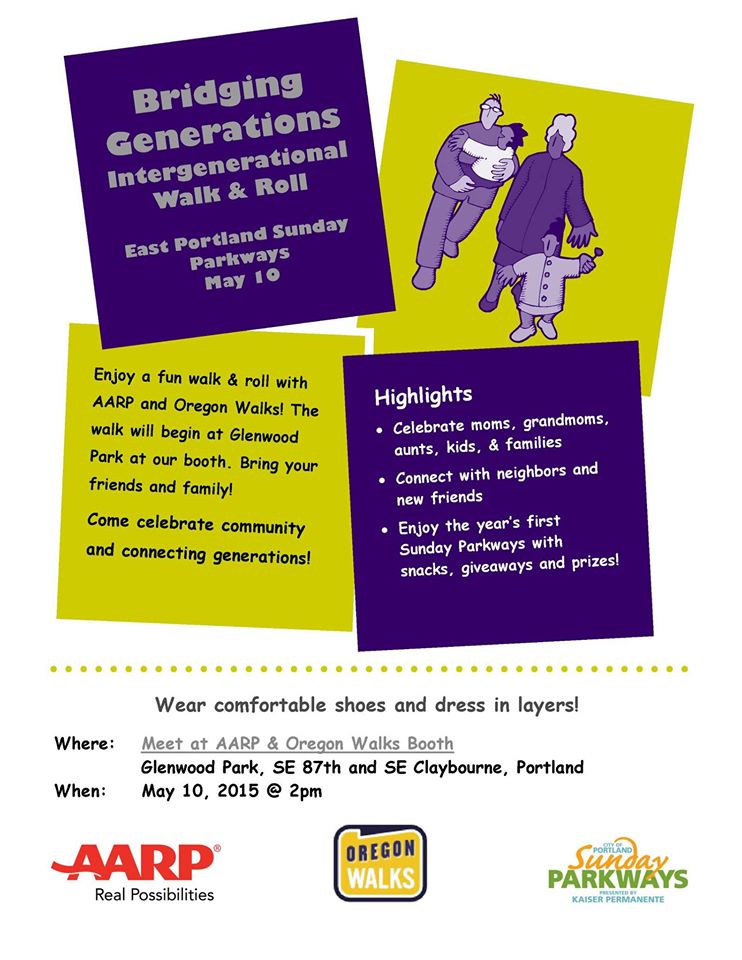AARP Hearing Center

By Elaine Friesen-Strang
How many of your family members or friends could you accept being killed or injured in traffic? The question prompts an immediate response: zero, of course! But everyday throughout America, adults and children are killed as they are walking to school, work, or just out for a stroll; it's what Vision Zero is hoping to change. According to Dangerous by Design, in the decade from 2003 through 2012, 47,025 people died while walking on our streets. Being a pedestrian shouldn't be a high risk activity.
Noel Mickelberry, Executive Director of Oregon Walks, finds that statistic appalling. We asked her about her non-profit and its advocacy efforts in a recent interview with AARP Oregon:
Oregon Walks has a great tagline, "Protecting your right to roam." What do you want people to know about your organization?
Oregon Walks works to make walking and the conditions for walking safe and attractive for everyone. That means that we work not only on policies and on-the-ground projects, but on engagement and encouragement as well. The wonderful thing about walking is it’s the most basic form of human transportation, and it’s free. When someone is walking or rolling they are connecting with their community in a much deeper way – and we want everyone to be able to experience that in a positive way. Protecting your right to roam means just that – it’s about transportation options, it’s about the ability for all members of our community to walk to where they work, play or pray.
AARP Oregon signed on in support of Vision Zero. What are you hoping to accomplish with this initiative?
Vision Zero puts forth the notion that traffic fatalities are unacceptable on our streets – that we must reach zero deaths on our roads. What we are hoping to accomplish at the core is a change in the status quo – a change in the acceptance of the inevitability of death and injury while getting from here to there. It starts with being that basic – we need to all be working together on the same vision in order to get the kind of results we want to see, which is safe streets for everyone.
Along with the Bicycle Transportation Alliance, you recently released new statistics in a report, "Our Healthy Streets". What numbers surprised you the most?
That 40% of all congestion is non-recurring and is caused primarily by crashes. Efficiency is often pitted against safety in funding and prioritization processes. When you see this statistic, it reminds you that the benefits of safe roads go beyond just preservation of life but to the way our system works and how it can work in a way that meets all the diverse needs of our residents and our communities. Safety needs to be the first priority and it doesn’t mean that to do that, we must compromise on efficiency.
The other statistic that is maybe not surprising, but really puts things in perspective, The top ten high crash corridors in Portland make up 36% of all traffic crashes, 53% of all pedestrian fatalities but are only 3% of the overall system. It is clear that high speeds, lack of safety infrastructure coupled with amenities and access to the rest of the city (transit) mean that more people are at risk of being injured in these places – and that means something needs to change. 
On April 25 you moved your office to a new location and in the process, remained true to your cause. Tell us about the move.
We moved by foot! Our new office location is only .3 miles from where we were before, and at the last minute I decided there was no better way to move than to move by foot. I put out a call to our members and supporters for volunteer help for a Walk Move on a day that looked likely to rain. 25 people showed up, it didn’t rain a drop, and we finished the entire move in 40 minutes. It was incredible! Our awesome volunteers even helped me set up my desk and files so that on Monday morning I could get right back to work. We are excited to be sharing our new space with the Community Cycling Center, a partner in active transportation.
Oregon Walks and AARP Oregon are inviting you to an intergenerational walk at the first Portland Sundays Parkways of the year: May 10, 2:00 PM in East Portland at Glenwood Park. All ages welcome. Celebrate walking and learn how you can advocate for pedestrian safety. Moms get a chocolate treat too!
###
Welcome to Livable Oregon.
What makes a community livable? What do neighborhoods need to help people of all ages live active, engaged lives? Livable Oregon explores the features of age-friendly communities, the people who help create them, and what we can do to make our neighborhoods in Oregon a great place for everyone.
This blog takes its lead from the AARP Livable Communities Initiative which seeks to improve the quality of life for older adults by promoting the development of safe, accessible, and vibrant environments. AARP Livable Communities policies address issues such as land use, housing, and transportation which are vital to developing communities that facilitate aging in place.
About our lead blogger:
My name is Elaine Friesen-Strang. I understand the need for lifelong, livable communities as a mother who raised two children, a daughter who helped care for her father, a professional guardian who served adults with developmental disabilities, and a woman who is experiencing the mixed blessings of aging. Volunteering for AARP empowers me to help make my neighborhood and city a more livable, sustainable place for people of all ages.































































